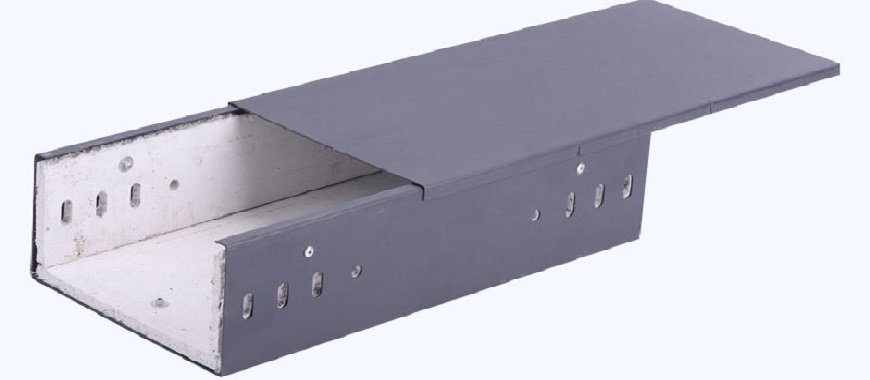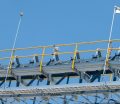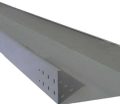
Fitting cable tray systems is essential for maintaining organized and efficient cable management in various settings. This guide focuses on offering practical insights into fitting cable tray securely and effectively. Whether you are installing on walls or ceilings, mastering proper techniques ensures a stable setup and reliable performance.The content covers step-by-step procedures for fitting cable tray, highlighting essential tools, safety tips, and common challenges. Detailed instructions for wall and ceiling installations are provided, along with recommendations for using accessories to enhance functionality.
By following this guide, you will gain the knowledge needed to handle fitting cable tray projects confidently and ensure compliance with installation standards. Every step is designed to simplify the process and improve overall cable management efficiency.
Fitting Cable Tray:Preparing for Installation
Tools and Materials Needed
Effective fitting cable tray systems starts with gathering the right tools and materials. Proper tools not only make installation efficient but also ensure a durable and secure setup.
One essential tool is a reliable measuring tape to ensure accurate placement of cable trays on walls and ceilings. Precise measurements are critical to prevent misalignments during installation.
Another key item is a power drill with appropriate drill bits. This tool simplifies creating mounting points for brackets or hangers, particularly in concrete or drywall surfaces.
Leveling tools, such as spirit levels, are vital for achieving straight and even installations. Uneven trays can compromise the stability and aesthetics of the setup.
Cable tray fittings and accessories, including brackets, screws, and clamps, must be selected carefully to match the tray type. Using high-quality fittings ensures proper attachment and enhances the longevity of the cable management system.
Finally, personal protective equipment (PPE), including gloves, goggles, and hard hats, should be worn to safeguard installers during the process.
Safety Precautions
When fitting cable tray systems, safety is a priority. Failing to adhere to safety protocols can lead to accidents or compromised installations.
- First, identify any potential hazards in the work area, such as loose debris or unstable surfaces. Clearing the workspace minimizes risks during installation.
- Second, always inspect tools and materials before use. Faulty equipment, such as worn drill bits or damaged trays, can result in poor performance and safety issues.
- Third, ensure that ladders or scaffolding are securely positioned when fitting cable tray to ceilings. Stability during elevated work prevents falls or injuries.
- Fourth, electrical systems should be deactivated in the installation area. This reduces the risk of accidental electrical shocks while working near existing wiring.
- Lastly, create a checklist to confirm all safety measures are in place before starting the installation. A systematic approach to safety fosters a secure work environment.
Why Choose a Vinyl Ester Cable Tray for Industrial Needs
Step-by-Step Guide to Fitting Cable Tray
Fitting Cable Tray to the Wall
Fitting cable tray on walls is a common practice for managing cables efficiently and keeping them organized.
When selecting the right tray for wall installations, consider the load capacity and material. GangLong Fiberglass trays are an excellent choice for their lightweight yet durable construction, making them suitable for most environments.
To install the tray securely, begin by marking the desired positions on the wall using a measuring tape and level. This ensures even alignment along the length of the tray.
Next, drill holes at the marked positions for mounting brackets. Ensure the spacing between brackets provides sufficient support to prevent sagging.
Attach the brackets securely with screws and mount the cable tray onto the brackets. Tighten the fasteners to eliminate any movement and ensure a stable setup.
Fitting Cable Tray to the Ceiling
Installing cable trays on ceilings requires additional care to ensure proper alignment and support.
Begin by identifying the optimal placement for the trays. The path should avoid obstacles like ductwork or existing wiring while providing easy access for future maintenance.
Drill anchor points in the ceiling for hangers or grp threaded rods. GangLong Fiberglass recommends using adjustable hangers to accommodate different tray heights and angles.
Attach the cable tray to the hangers, ensuring it is level. Use a spirit level to confirm alignment and make adjustments if necessary.
Secure all connections tightly, and verify that the tray is firmly supported along its length. Regularly spaced supports prevent sagging and enhance the system’s overall stability.
Fitting Cable Tray:Installation Procedure
Step-by-Step Installation Process
Setting up a fitting cable tray system involves several key steps to ensure reliability and efficiency.
- Begin by preparing a layout plan for the trays. This plan should outline the routes, connection points, and dimensions, considering the specific cable tray requirements to streamline the installation process.
- Next, assemble the required cable tray sections. GangLong Fiberglass offers a range of modular trays that can be customized to fit specific project needs.
- Install the trays section by section, starting from the designated starting point. Attach each section securely before proceeding to the next to maintain alignment.
- Route the cables through the trays, ensuring that they are evenly distributed. Use cable ties or clamps to prevent cables from shifting during operation.
- Inspect the completed setup to confirm that all connections are secure, and make adjustments if needed. A thorough inspection ensures the system functions as intended.
Using Installation Guides and Catalogs
Installation guides and catalogs are invaluable resources when fitting cable tray systems. They provide detailed instructions and specifications for various tray types and configurations.
Refer to catalogs for GangLong Fiberglass trays to identify compatible accessories. Using recommended accessories ensures a seamless installation and avoids compatibility issues.
Installation guides often include troubleshooting tips for common challenges, such as uneven surfaces or misaligned trays. Following these tips simplifies the installation process.
Detailed diagrams in the guides assist in visualizing the tray layout and connection points. These visuals are particularly helpful for complex installations.
By utilizing these resources, installers can achieve precise and efficient setups while minimizing errors and rework.
Innovative PW Cable Tray Designs for Modern Infrastructure
Fitting Cable Tray:Maintenance and Troubleshooting
Regular Inspection and Upkeep
Regular upkeep of cable trays ensures their efficiency and longevity. Fitting cable tray systems requires attention to maintenance to prevent damage or performance issues.
Inspect trays periodically as part of your cable tray inspection routine for visible signs of damage, such as cracks or deformations. Using GangLong Fiberglass trays, which are built to withstand environmental stress, helps reduce such risks but doesn’t eliminate the need for checks.
Secure fittings and fasteners during inspections. Loose brackets, screws, or hangers compromise the stability of the fitting cable tray system and increase the chance of disconnections.
Clean the trays of debris and dust regularly. Accumulated debris can obstruct airflow, cause overheating in cables, or weaken the tray structure over time.
Examine cables for any signs of wear or damage. Properly routed and secured cables prevent strain on the fitting cable tray and improve overall system reliability.
Implement a maintenance log to track inspections and repairs. Keeping a record ensures timely actions and helps in planning for accessory updates or system expansions.
Upgrading with Accessories
Enhancements to an existing fitting cable tray system provide better functionality and adaptability to changing requirements.
Install dividers to organize and separate cables. GangLong Fiberglass dividers help avoid interference between power and data cables while maintaining the structure of the tray.
Add covers to trays in exposed environments. Covers protect cables from dust, water, and other external elements, ensuring better durability for the system.
Use splice plates to extend cable tray systems. GangLong Fiberglass splice plates allow seamless expansion while maintaining the structural integrity of the tray.
Integrate additional brackets for extra stability. Adjustable brackets enable modifications without replacing the existing fitting cable tray, offering flexibility for future upgrades.
Include labeling systems to simplify cable identification. Proper labeling reduces downtime during maintenance and prevents mismanagement of cable routing.
Why Choose a Cable Foil Cable Tray for Data Centers
Final Thoughts on Fitting Cable Tray
The Importance of Planning and Preparation
Fitting cable tray systems successfully relies on meticulous planning, proper installation, and regular maintenance. Each step, from preparing tools and ensuring safety to addressing specific challenges for walls or ceilings, contributes to a durable and efficient cable management system. For certain setups, using a flat cable tray can be an ideal choice, offering a streamlined design that simplifies installation and maximizes space utilization while maintaining the system’s functionality.
Using Structured Installation Guides
Following structured installation guides, like those provided with GangLong Fiberglass products, simplifies the process and minimizes errors. These guides ensure precision and provide practical solutions for seamless installation.
Enhancing Functionality with Accessories
The use of quality accessories enhances functionality and allows for future expansions. Accessories such as dividers, splice plates, and covers improve the adaptability and durability of the system.
Ensuring Long-Term Reliability
By adhering to best practices and maintaining fitting cable tray systems over time, users ensure safety, efficiency, and reliability in various operational environments. Regular inspections and upgrades keep the system performing optimally for years to come.
FAQs about Fitting Cable Tray
Installing cables in a cable tray involves several steps to ensure organization and functionality. Start by planning the cable layout to determine the required tray length and route. Carefully select a tray size that accommodates the total cable volume without overcrowding. Place the cables evenly in the tray to avoid excessive weight on one side. Secure the cables using cable ties or clamps to prevent them from shifting or sagging during use. Ensure the cables are routed along their designated paths and avoid sharp bends to minimize strain on the wires. Finally, inspect the tray after installation to verify proper alignment and cable distribution.
A cable tray fitting is a component designed to connect, extend, or alter the direction of a cable tray system. Commonly used fittings include bends, tees, elbows, and junctions. These fittings enable the tray to follow the architectural layout of the building while maintaining proper cable routing. Fittings are essential for ensuring a seamless and stable connection between tray sections. They also support efficient transitions around corners, obstacles, or intersections. Selecting the appropriate fitting ensures that the tray remains sturdy and the cables are protected during installation and operation.
The BS (British Standards) specification for cable tray installation is outlined to ensure safety, durability, and compliance. BS EN 61537 is the key standard governing cable tray systems. This standard specifies the requirements for construction, testing, and performance of metallic cable trays and associated fittings. It emphasizes load capacity, corrosion resistance, and electrical continuity to ensure safe cable management. Adhering to this standard guarantees that the installation meets legal and industry safety requirements while providing reliable cable support. Installers should follow the specific guidelines in the standard for spacing, fitting selection, and support placement during installation.
The five basic cable tray fittings are bends, tees, elbows, reducers, and junctions. Bends allow the tray to change direction horizontally or vertically, facilitating navigation around corners or obstacles. Tees split the tray system into two paths, enabling cables to branch out in different directions. Elbows are specialized fittings for sharp directional changes, especially in confined spaces. Reducers connect trays of varying widths, ensuring compatibility when transitioning between different tray sizes. Junctions, including cross junctions, enable multiple tray systems to intersect efficiently. Each fitting serves a specific purpose and ensures smooth cable transitions while maintaining system stability and alignment.

As the editor of GangLong Fiberglass, I have years of experience and in-depth research, focusing on cable tray products, fiberglass solutions, and grille systems. I incorporate years of industry insights and practical experience into every content, committed to promoting the progress of the industry. At GangLong Fiberglass, my commitment is reflected in every product, from innovative cable trays to durable fiberglass solutions and sturdy grille systems. As an authoritative voice in the industry, my goal is to provide valuable information to professionals and businesses and promote forward-looking solutions.


